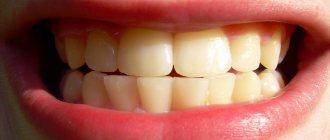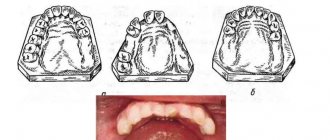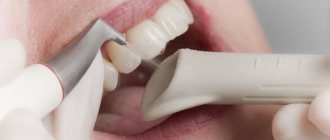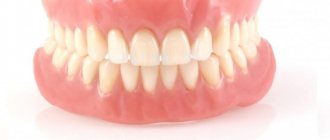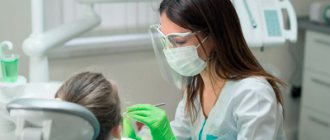The rules for caring for removable dentures are simple and clear - they are very important to follow in order to avoid unpleasant phenomena: shortening the service life of the structure, the appearance of an unpleasant odor, and inflammatory diseases of the oral cavity.
Using a regular toothbrush and toothpaste out of habit can render a denture unusable - this will cause small scratches on the structure and significantly reduce its service life. The result of such improper care is the accumulation of dental plaque and the proliferation of bacteria on the surface due to roughness. That is why it is very important to know several basic rules of care - by following them, you will extend the life of the prosthesis and minimize the risk of complications from wearing it.
How long does it take to get used to removable dentures?
On average, 30 days. At the beginning of use, removable dentures feel like a foreign body and can cause discomfort. They can interfere with the production of sounds (diction), cause increased salivation, changes in taste and temperature sensations, and difficulty biting and chewing food. Sometimes, when applying removable dentures, the urge to vomit may occur. It is also possible that the dentures do not adhere satisfactorily, or food debris gets underneath them, or biting the cheeks, lips, or tongue. All these phenomena decrease by the end of the first week of wearing the prosthesis and disappear after 3-4 weeks. After an adaptation period, the patient already feels more comfortable with prostheses than without them.
The main condition for quickly getting used to prostheses is their constant use. The rules and recommendations below will help you shorten the adaptation period.
How to quickly get used to new dentures
- Immediately after submitting the finished work in the dentist’s chair, learn how to remove and put on removable dentures yourself. At home, practice again, first in front of a mirror, then without it.
- Before applying, soak removable dentures in water or use a fixative.
- For the first one and a half to two weeks after the application of dentures, they should not be removed from the mouth, even at night. Take them out only for cleaning and oral hygiene.
- To reduce the gag reflex, try sucking the candy by placing it towards the roof of your mouth and holding it in this position with your tongue.
- Rinse your mouth often with warm water (8-10 times a day) or drink hot tea.
- Reading aloud in a calm, relaxed atmosphere for 2 hours helps to quickly restore correct pronunciation. In most patients, diction is restored quite quickly (after 5-6 days)
- For the first 2-4 days of wearing the prosthesis, try to eat soft foods and not load the prosthesis until you fully adapt to it. Try not to bite with your front teeth. Chew your food slowly and thoroughly.
- Chew food with your side teeth at the same time (left and right at once). Cut food into small pieces. Introduce more fruits and vegetables into your diet (this will allow you to switch to your usual diet earlier).
Professional cleaning
Dental professional cleaning of the surface of dentures from darkened areas can be pharmacological and mechanical. For pharmacological purification, special effervescent tablets from different companies are used. The principle of action of all tablets is almost the same. Minor differences are due to additional functions (besides cleansing). Tablet cleansing is based on the following universal characteristics.
- Contains disinfectants and active oxygen.
- The ability of the composition to penetrate hard-to-reach places.
- Flavoring properties.
- Protection against corrosion and other defects.
The composition of cleaning tablets includes oxidizing agents, chelates (cyclic complex compounds) and detergents (surfactants with cleaning properties; unlike soap, they do not form foam upon contact with water), which eliminate pathogenic microbiota of the oral cavity and prevent the development of corrosion (destruction of metals). and alloys due to interaction with physicochemical, chemical and electrochemical, but not physical external factors).
Special additives have a flavoring effect, which contributes to a pleasant breath odor. Proteolytic enzymes included in the tablets destroy food debris. For example, Corega tablets are distinguished by the presence of a silicone polymer, which forms a film on the prosthesis and does not allow microorganisms to settle, and also whitens the prostheses.
"Paro Care" contains tin fluoride, which is aimed at preventing carious processes in the tooth and whitening dentures. Tablets from some companies have stronger antibacterial or deodorizing effects.
Rules for cleaning dentures using chemical methods.
- Clean the denture mechanically using a toothbrush and floss.
- Dissolve one cleansing tablet in a glass half filled with boiled water.
- Place the removable denture in the solution for twenty minutes.
- Rinse the removable denture treated with the solution with water before use. Otherwise, irritation of the oral mucosa may occur.
- Dry the prosthesis.
Important ! Cleansing should be done twice a day, morning and evening.
In advanced cases, fixed structures are cleaned mechanically in the dental office. Mechanical dental cleaning is performed using Air Flow technology (a mixture of air flow and soft abrasive is supplied, which cleans the surface, including in hard-to-reach places). The procedure is short-term, painless and does not cause hypersensitive reactions.
There is also a method of non-contact mechanical cleaning using ultrasound. This method is used to clean mainly removable structures. Ultrasound leads to such a physical phenomenon as cavitation. Cavitation is the process of formation and subsequent collapse of vacuum bubbles in a liquid flow. The process is accompanied by hydraulic shocks and noise. In this way, darkened areas of the prosthesis are eliminated and the integrity of the material is maintained.
Another method of cleaning the prosthesis is the use of an irrigator.
Interesting ! An irrigator is a special dental device designed primarily for cleaning fixed structures.
Supplying a jet of liquid saturated with air under pressure helps cleanse the most inaccessible places in the oral cavity. It is advisable to use an irrigator after preliminary cleaning of the teeth. The design of the irrigator is as follows:
- hydraulic pump;
- container for liquid;
- replaceable nozzles.
Water can be supplied in different modes: spraying, pulsating or constant. The nozzles are also distinguished by their variety. A special tongue cleaner prevents the development of halitosis (bad breath); orthodontic is intended for cleaning orthodontic structures (structures for correcting incorrect position of teeth and bite, for example, braces); periodontic - for irrigation and antiseptic treatment of cavity pockets, etc.
It is not advisable to use the irrigator for people with inflamed periodontal disease and for children who do not know how to use a toothbrush independently (in such cases, dentures are not installed). The irrigator can be used not only for mechanical cleaning of fixed dentures, but also for supplying antiseptics and coagulants (can be used instead of water); massage of the gums and oral mucosa; cleaning hard-to-reach places.
The device is used after evening brushing of teeth.
- Water or an antiseptic is placed in the liquid reservoir.
- The nozzle is placed at right angles to the gum. Then you need to lean towards the sink so that the liquid can flow freely from the mouth.
- The device turns on. The procedure lasts from five to fifteen minutes.
What are the main rules when using removable dentures?
Dentures must be clean. After each meal, they should be removed from the mouth and washed thoroughly with soap and water.
Removable dentures should be protected from mechanical and chemical damage, as well as from exposure to high temperatures. If cracks or breakages appear in a removable denture, you cannot use it; you must consult a doctor for repairs.
Do not take breaks from wearing a prosthesis for more than one and a half to two weeks, because... this can lead to an initial discomfort that can make it difficult to fit the prosthesis exactly into place. As a rule, if a prosthesis is not used for more than a month, it becomes unusable and a new one needs to be made.
We use ultrasonic baths
Another effective remedy is special ultrasonic baths. With their help, you can clean the denture from stone and plaque, eliminate unpleasant odors, and eliminate harmful microorganisms and bacteria.
If you buy an ultrasonic bath, you can save on additional chemicals. In addition, there will be no need to use a toothbrush. Such baths cost about 2,800 rubles for 2018.
On a note! In addition to dentures, these baths can be used to clean baby nipples and bottles, as well as jewelry.
Video - How to care for artificial teeth
What is prosthesis correction and when should it be done?
After applying removable dentures in the oral cavity, as a rule, pain appears in some areas underneath. This is due to the inevitable gradual subsidence (pressure) of the removable denture on the mucous membrane. This factor cannot be fully taken into account when designing these orthopedic structures, therefore, correction is necessary to eliminate unpleasant sensations. It consists of “undermining” the dentures in those areas where it presses on the oral mucosa.
The first correction must be carried out the next day after the start of using dentures. The next 3-4 corrections must be carried out over a period of one and a half to two weeks as necessary. You may need more visits to the dentist after completing your work (up to 10).
In case of severe pain, you need to remove your dentures and put them in a special container or glass of water. Before going to the doctor for correction, you must wear dentures and walk around with them for at least 3-4 hours. This will allow the doctor to see a clear imprint on the mucous membrane and correct only the place that is rubbing the gum. Bringing a denture in your pocket and pointing your finger in your mouth is useless. In removable dentures, every centimeter, and sometimes even a millimeter, of the supporting surface is of great importance. If the correction is inaccurate, the fixation of the prosthesis may be impaired. This is exactly what happens if you try to grind or file dentures yourself. After correction (adjustment) of removable dentures, you must not use them for 1 day. During this period (during the healing period of the namin), it is advisable to rinse your mouth and make baths (hold the solution in the mouth at the site of the namin) with herbal decoctions. Use a decoction of chamomile flowers, oak bark, etc. For example, take 0.5 tablespoons of dry oak bark, brew in one glass of boiling water, cool, apply the decoction 3-5 times a day. You can also use medicines, for example Kamistad gel, sold in pharmacies.
Feel free to visit your dentist for adjustments. Removable dentures, even if they are made in the most careful manner, require correction. Even if you do not experience any pain or discomfort, you should visit the dentist for an oral examination.
WARNING : Do not attempt to straighten dentures yourself with a file or any other tool. This can lead to breakage of the prosthesis and disruption of its fixation. Moreover, after such “repairs” it is no longer possible to do anything with the prostheses in the clinic. As a result, all that remains is the manufacture of new orthopedic structures.
How to care for removable dentures
Proper care of them is of great importance for the period of adaptation (adaptation) and the service life of prostheses. Removable dentures require regular cleaning. The best option is to clean dentures daily after each meal under running water. The obligatory minimum is cleaning the prosthesis before going to bed. The main criterion is that the prosthesis must be as clean as on the first day. The cleaner the denture, the more comfortable you will feel it in your mouth.
When cleaning a denture with whitening toothpaste, scratches may form on it, which contributes to the rapid accumulation of plaque on the denture, because Such pastes contain abrasive substances, so for daily care you can use a weak soap solution.
Dirty removable dentures cause rapid wear and tear and inflammation in the oral cavity. If there is inflammation of the mucous membrane in places of contact with a removable denture, pain, or burning, you should immediately consult a doctor. From strong tea, coffee and smoking, removable dentures lose their appearance, turn yellow, and a brown coating appears on them. With good care, removable dentures retain their color and shine for a long time.
An indicator of good care is the absence of food and plaque on the prosthesis. To remove age spots from coffee and nicotine, etc., which may appear over time, you should consult a doctor. The dental technician will restore the necessary polish and shine.
To clean dentures, you can use special cleaning agents sold in pharmacies (President, Corega, Protefix). They also help get rid of plaque and destroy bacteria that cause bad breath. The prosthesis is placed in a glass of clean water and a tablet is lowered; the prosthesis is kept in the solution for a certain time recommended by the manufacturer.
Why does dark plaque appear?
Typically, dark areas on dentures are the result of plaque. The latter spreads very actively in the absence of sufficiently frequent cleaning of the structure.
So, plaque is formed from:
- leftover food;
- cigarette smoke;
- dead bacteria and cells;
- food colors.
On a note! It is advisable to use a simple toothbrush with soft bristles for mechanical cleaning of dentures. The use of tooth powder is also allowed. Daily cleaning itself, by the way, is very important - if this is not done, then it will be much more difficult to remove plaque in the future.
Also remember that there are special toothpastes for dentures.
How to improve the fixation of removable dentures
The anatomical conditions in the oral cavity do not always allow for the creation of good fixation for removable dentures. This especially applies to prosthetics for the complete absence of teeth in the lower jaw. Under unfavorable conditions, special fixing agents in the form of creams, fixing pads, and powders are used to keep it in the mouth. They are sold under the brands “President”, “Corega”, “Protefix” in any pharmacy.
The fixing cream is applied in a thin broken line to the prosthesis. Before applying the cream, removable dentures must be dried, for example with a cotton swab. Fixing powder is used for low salivation. It is applied in a thin layer to the wet denture, after which the removable dentures can be put on. Your dentist will help you decide on the choice of fixative.
What to do if your prosthesis breaks?
During the use of removable dentures, a fracture of the prosthesis or its individual parts (tooth, clasp) may occur. In this case, you need to consult a dentist. If a tooth(s) on which partial removable dentures are held or supported are lost, it is possible to weld an artificial tooth to the denture in place of the lost one. Repairing a removable denture takes 2-3 days. Repairs are made without warranty.
In case of cracks, fractures, etc. Do not try to fix the denture yourself, even if urgently. Only specialists can repair the prosthesis.
Making new removable dentures takes about 1 week. The warranty period for plastic removable and clasp dentures is usually up to 1 year. During the warranty period, the prosthesis is repaired or altered free of charge. After the warranty period expires, the work is paid in full.
In what cases is it necessary to contact a dentist?
If you notice a burning sensation in the mucous membrane, severe dry mouth, skin rash and other unusual symptoms, you should contact your dentist, who, if necessary, will refer you to an allergist for allergy tests.
Once a year it is necessary to reline the removable denture. The fact is that while wearing a prosthesis, atrophy of the mucous membrane and bone tissue occurs under it. Because of this, a void appears between the prosthesis and the mucous membrane and the prosthesis does not fit tightly to the prosthetic bed. To eliminate these negative aspects, the prosthesis is relined - plastic is placed in place of the void formed due to atrophy and a tight fit of the prosthesis is restored. If relining a removable denture is done at the wrong time or not done at all, the removable denture becomes unusable.
Visit your dentist at least twice a year, consult with him about the specifics of caring for your oral cavity, and use special devices and medications recommended by him, if necessary!
Alternative remedies
In addition to pharmacological, technical and professional methods of cleaning and whitening dentures, there are a number of folk methods that are preferred due to their accessibility and simplicity. The following substances are used for cleaning.
| Substance, means | Description |
| Sodium bicarbonate (soda) | The denture is cleaned with a toothbrush, onto which a soda paste has previously been applied (acts as an antiseptic and abrasive). Sedum cleaning with soda is preferable for removable structures, since the pressure and intensity of the cleaning process are easier to control. Cleaning fixed structures is fraught with irritation of the oral mucosa and bleeding from the gums. Frequency of application: once every ten days. |
| Sodium chloride (salt) | Abrasive material. The cleaning technique is similar to the previous method. Salt is applied to a damp toothbrush. Finely ground table salt is selected to reduce the abrasive effect. Because the plastic wears less, the acceptable frequency of use increases to once every five days. |
| Lemon juice | Organic acids in citrus fruits corrode the dyes in food and drinks, which contribute to the darkening of dentures. The content of corrosive acids in the pulp is higher than in the peel. A mixture of lemon juice and salt is used to rinse the oral cavity twice a week. More frequent use is fraught with the aggressive effect of citric acid on the prosthesis material and on the oral cavity itself. |
| Hydrogen peroxide | The use of this substance is based on the content of active oxygen in the composition. The permissible concentration of peroxide is 3%. Method of application: rubbing with a cotton swab into the denture. Frequency of procedure: twice a month. |
| Banana peel | The advantage of banana peels over citrus fruits is their lower content of citric acids, so treating the prosthesis with this method can be done relatively more often: daily. Directions for use: the oral cavity is cleaned with a toothbrush and classic hygiene products, and rinsed with water. The denture is rubbed with the inside of the peel. The banana residue is left for ten minutes and washed off. The effect should be expected after about seven days. |
| Vinegar solution | The removable structure is placed in the solution for two hours. Frequent use of this method can lead to damage to the prosthesis. |
When choosing any of the above products, you should take into account the type of structure and the material from which it is made. Folk remedies prevent the penetration of infections and are more suitable for preventive measures than for directly cleaning darkened areas of dentures. It should be noted that the main cause of blackened areas is inadequate cleaning, so compliance with the necessary hygiene measures applicable to the oral cavity is the most important preventive method.
Important ! The service life of the prosthesis increases significantly with proper care.
It is better to include folk remedies as additional cleansing measures. If the dental structure darkens, it is wiser to consult a dentist, especially if the darkening of the denture is accompanied by other local symptoms.
